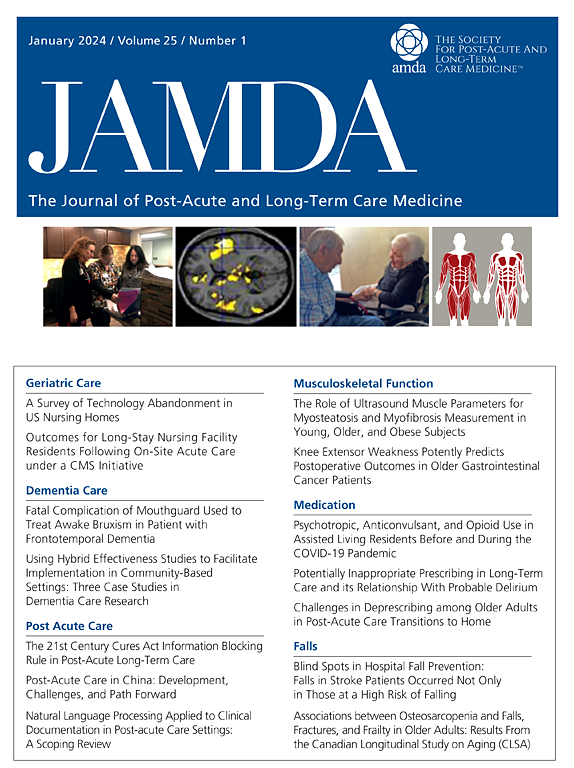COVID-19 期间长期护理院工作人员的解离:挑战与可行做法。
IF 4.2
2区 医学
Q2 GERIATRICS & GERONTOLOGY
Journal of the American Medical Directors Association
Pub Date : 2024-11-16
DOI:10.1016/j.jamda.2024.105357
引用次数: 0
摘要
目的:长期护理(LTC)工作人员可能会因为高压力的工作环境和创伤暴露而产生解离。本研究旨在:(1)评估COVID-19大流行期间长期护理中心工作人员病理性解离的发生率;(2)研究病理性解离与人口统计学特征、心理健康、失眠和职业生活质量的关联;以及(3)研究病理性解离是否对连贯呼吸干预后的变化敏感:我们分析了 2022 年 1 月至 9 月期间进行的一项前-后呼吸干预研究的数据:参与者是来自加拿大艾伯塔省31家长期护理院的254名工作人员(护理助理、护士和管理人员):方法:我们使用分离体验量表(DES-T)测量病理性分离。我们进行了χ2检验和t检验,以检验病理解离与干预前其他变量之间的关联。我们使用了2级随机截距逻辑回归分析来研究病理分离从干预前到干预后的变化:结果:干预前和干预后,分别约有 12% 和 8% 的样本出现病理性分离。病态解离与压力、心理困扰、焦虑、抑郁、创伤后应激障碍和失眠有显著关联(P < .05);与语言、种族和职业角色也有显著关联(P < .05)。与干预前相比,干预后参与者出现病理性解离的几率较低(几率比为 0.41;P = .045):在 COVID-19 期间,长者护理之家的工作人员表现出较高的病态解离率,这与其他心理健康指标有显著关联。连贯呼吸干预显示出减少解离报告的潜力。要了解长者护理中心工作人员的解离现象及其与心理健康结果、睡眠质量和个人/工作相关因素之间的相互作用,还需要进一步的研究。了解工作环境的作用并评估针对工作条件的干预措施,可以减轻解离现象并促进创伤知情工作场所的发展。需要进行严格的研究设计,为连贯呼吸等非药物干预措施提供更有力的证据。本文章由计算机程序翻译,如有差异,请以英文原文为准。
Dissociation in Long-Term Care Home Staff During COVID-19: Challenges and Promising Practices
Objectives
Long-term care (LTC) staff may develop dissociation due to high-stress work environments and trauma exposures. This study aimed to (1) assess the prevalence of pathological dissociation in LTC home staff during the COVID-19 pandemic; (2) examine the associations of pathological dissociation with demographic characteristics, mental health, insomnia, and professional quality of life; and (3) examine whether pathological dissociation was sensitive to change following a coherent breathing intervention.
Design
We analyzed data from a pre-post breathing intervention study conducted between January and September 2022.
Settings and Participants
Participants were 254 staff (care aides, nurses, and managers) from 31 LTC homes in Alberta, Canada.
Methods
We measured pathological dissociation using the Dissociative Experiences Scale-Taxon (DES-T). We conducted χ2 test and t tests to examine the association of pathological dissociation with other variables pre-intervention. We used a 2-level random intercept logistic regression analysis to examine the change in pathological dissociation from pre- to post-intervention.
Results
About 12% and 8% of the sample experienced pathological dissociation pre- and post-intervention, respectively. Pathological dissociation was significantly associated with stress, psychological distress, anxiety, depression, posttraumatic stress disorder, and insomnia (P < .05); it was also significantly associated with language, race, and professional role (P < .05). Participants had lower odds of experiencing pathological dissociation post-intervention compared with pre-intervention (odds ratio, 0.41; P = .045).
Conclusions and Implications
LTC home staff exhibited a high prevalence of pathological dissociation during COVID-19, significantly linked to other mental health measures. A coherent breathing intervention showed potential in reducing reports of dissociation. Further research is needed to understand dissociation in LTC staff and its interplay with mental health outcomes, sleep quality, and personal/work-related factors. Understanding the work environment's role and assessing interventions targeting working conditions could mitigate dissociation and promote a trauma-informed workplace. Rigorous study designs are needed to generate stronger evidence for nonpharmacological interventions like coherent breathing.
求助全文
通过发布文献求助,成功后即可免费获取论文全文。
去求助
来源期刊
CiteScore
11.10
自引率
6.60%
发文量
472
审稿时长
44 days
期刊介绍:
JAMDA, the official journal of AMDA - The Society for Post-Acute and Long-Term Care Medicine, is a leading peer-reviewed publication that offers practical information and research geared towards healthcare professionals in the post-acute and long-term care fields. It is also a valuable resource for policy-makers, organizational leaders, educators, and advocates.
The journal provides essential information for various healthcare professionals such as medical directors, attending physicians, nurses, consultant pharmacists, geriatric psychiatrists, nurse practitioners, physician assistants, physical and occupational therapists, social workers, and others involved in providing, overseeing, and promoting quality

 求助内容:
求助内容: 应助结果提醒方式:
应助结果提醒方式:


